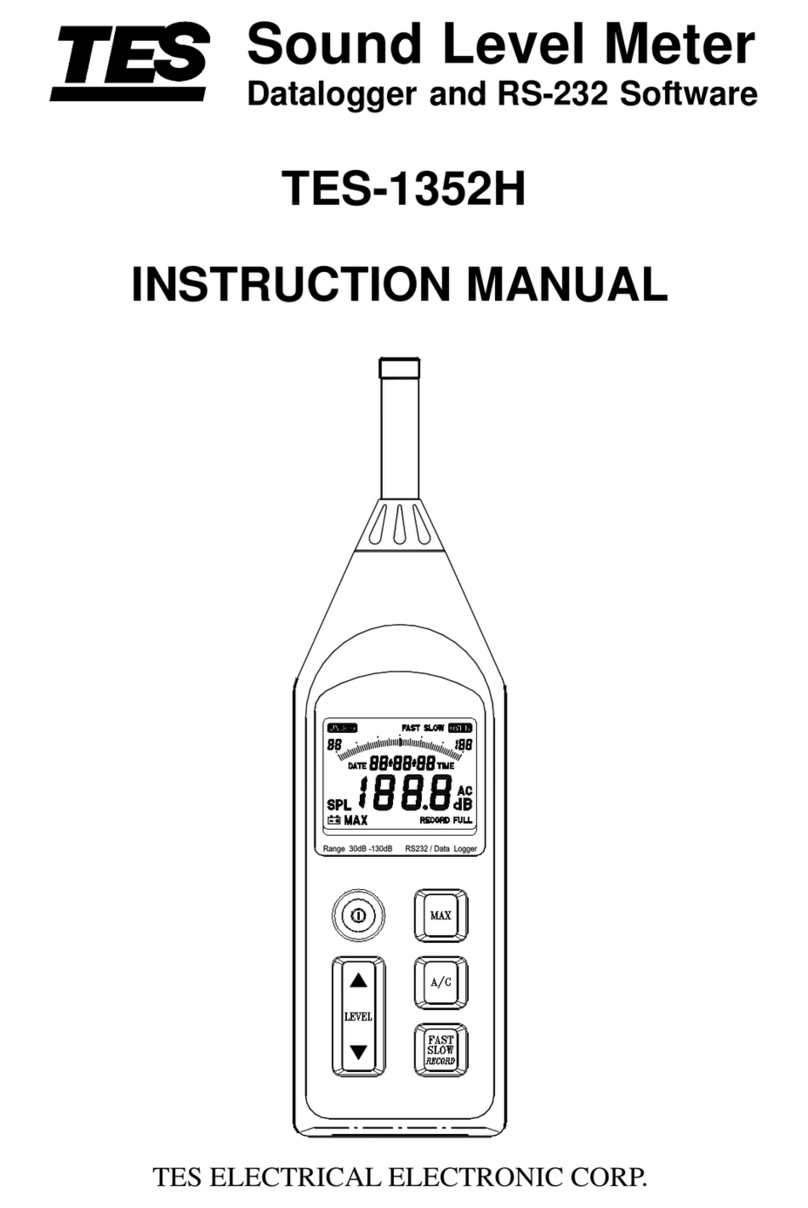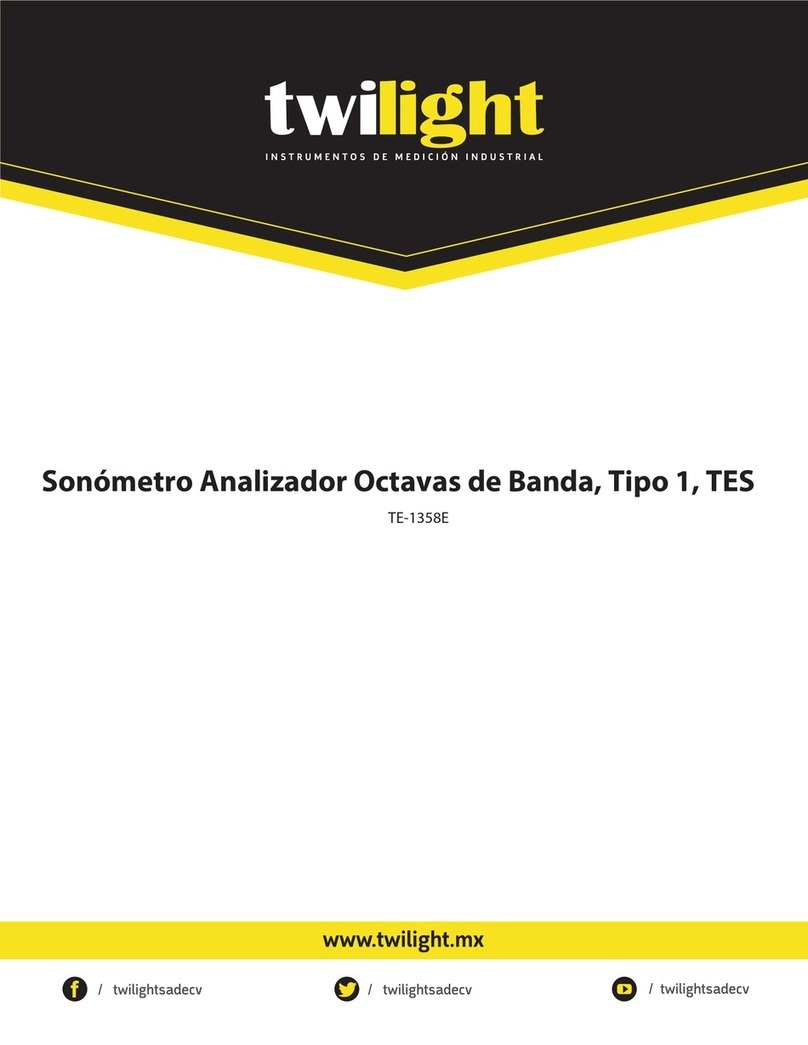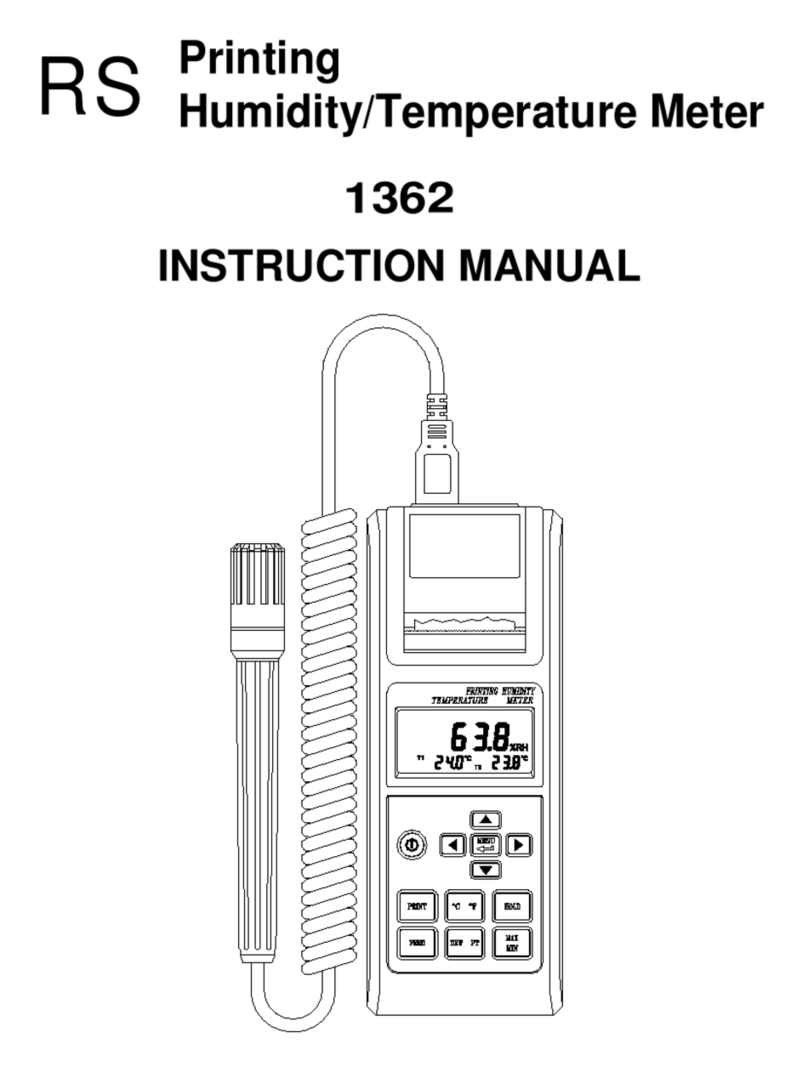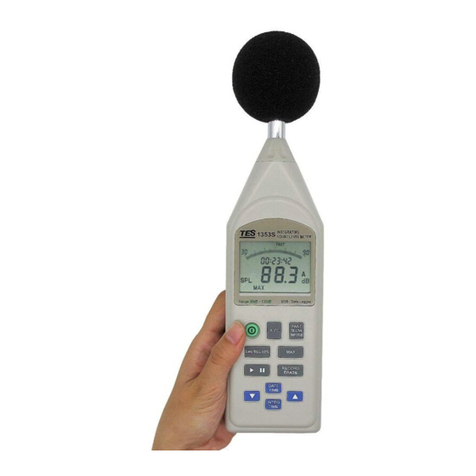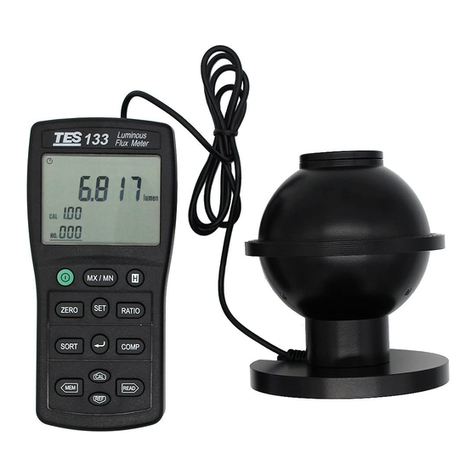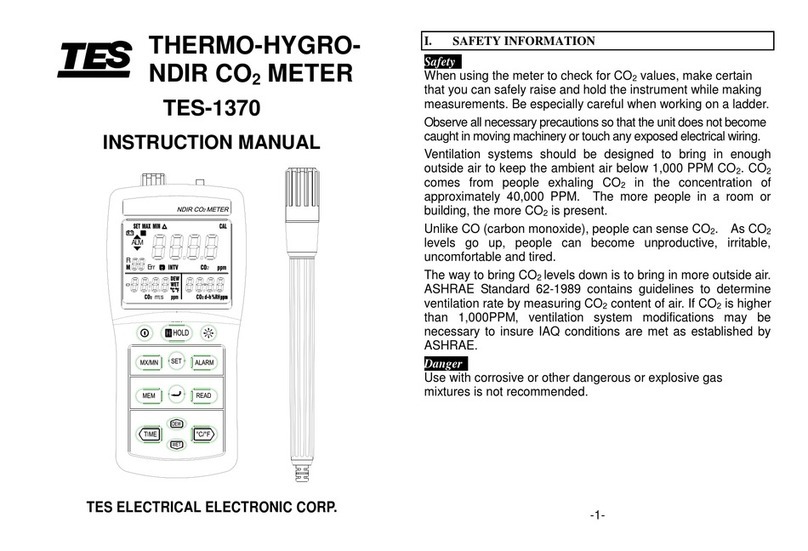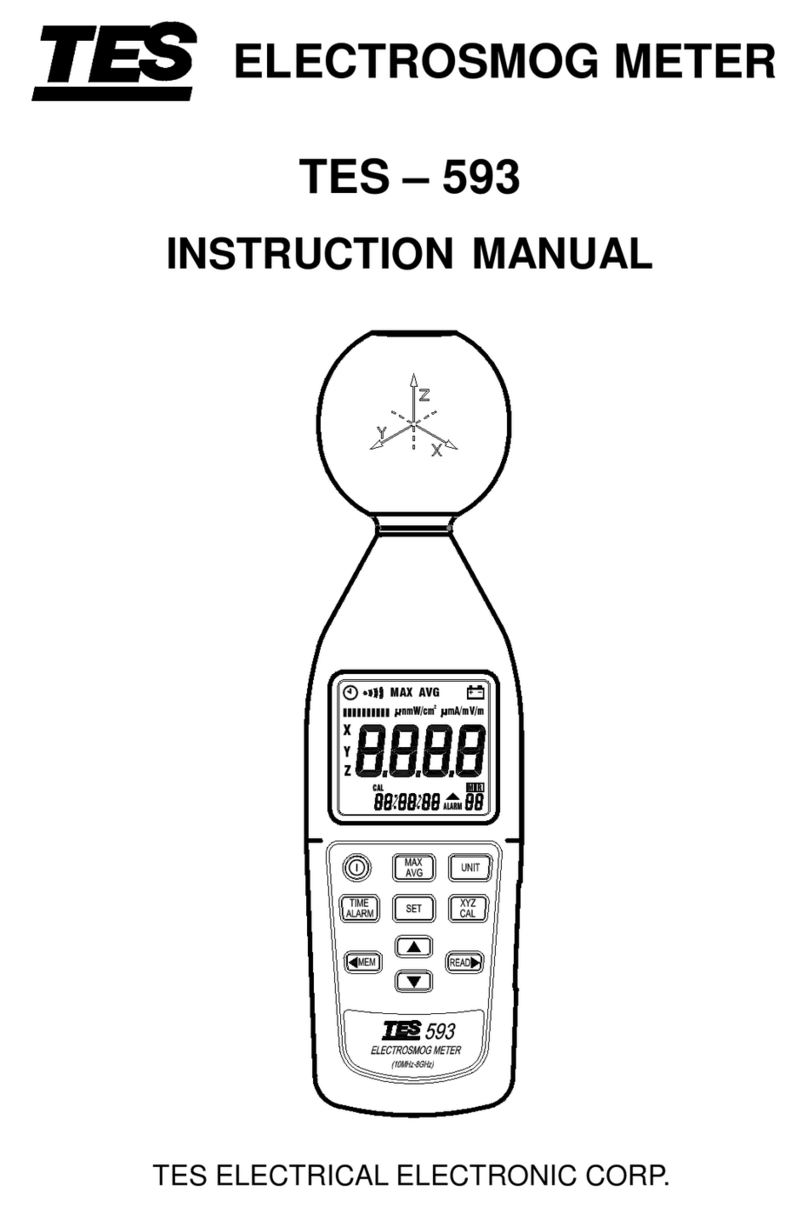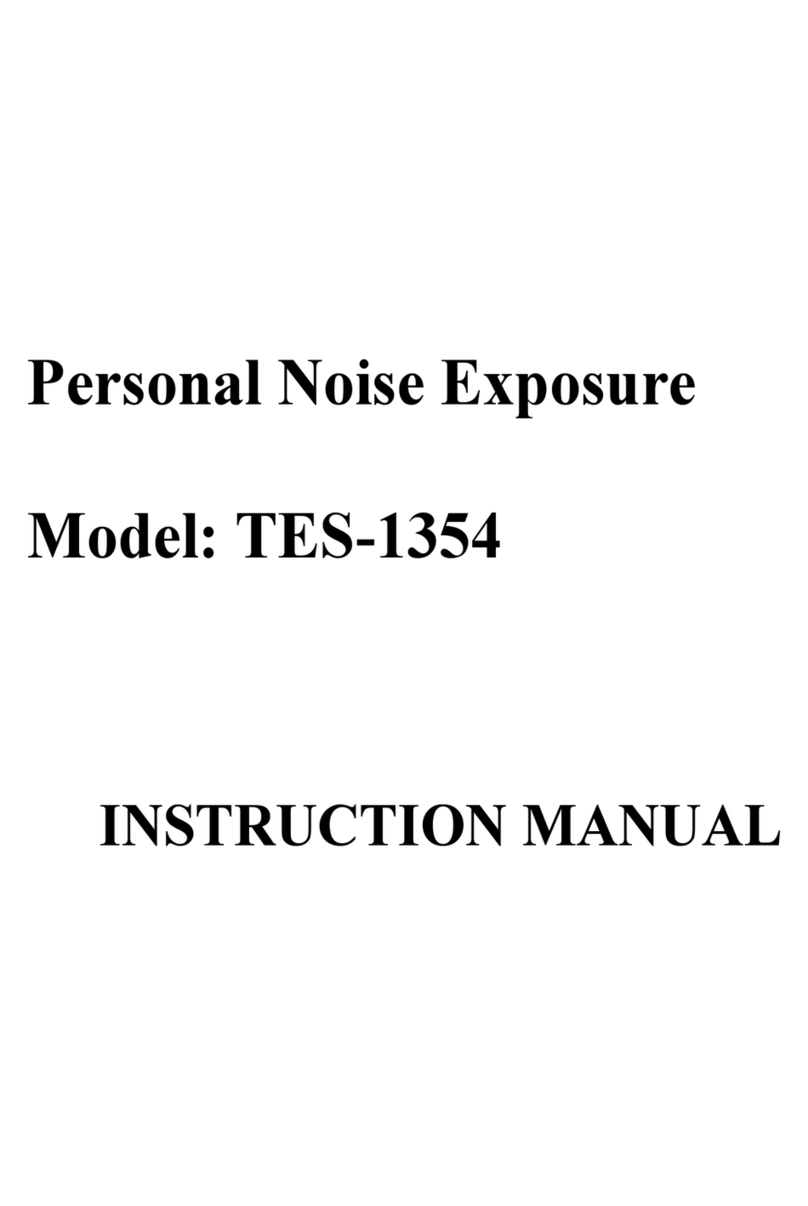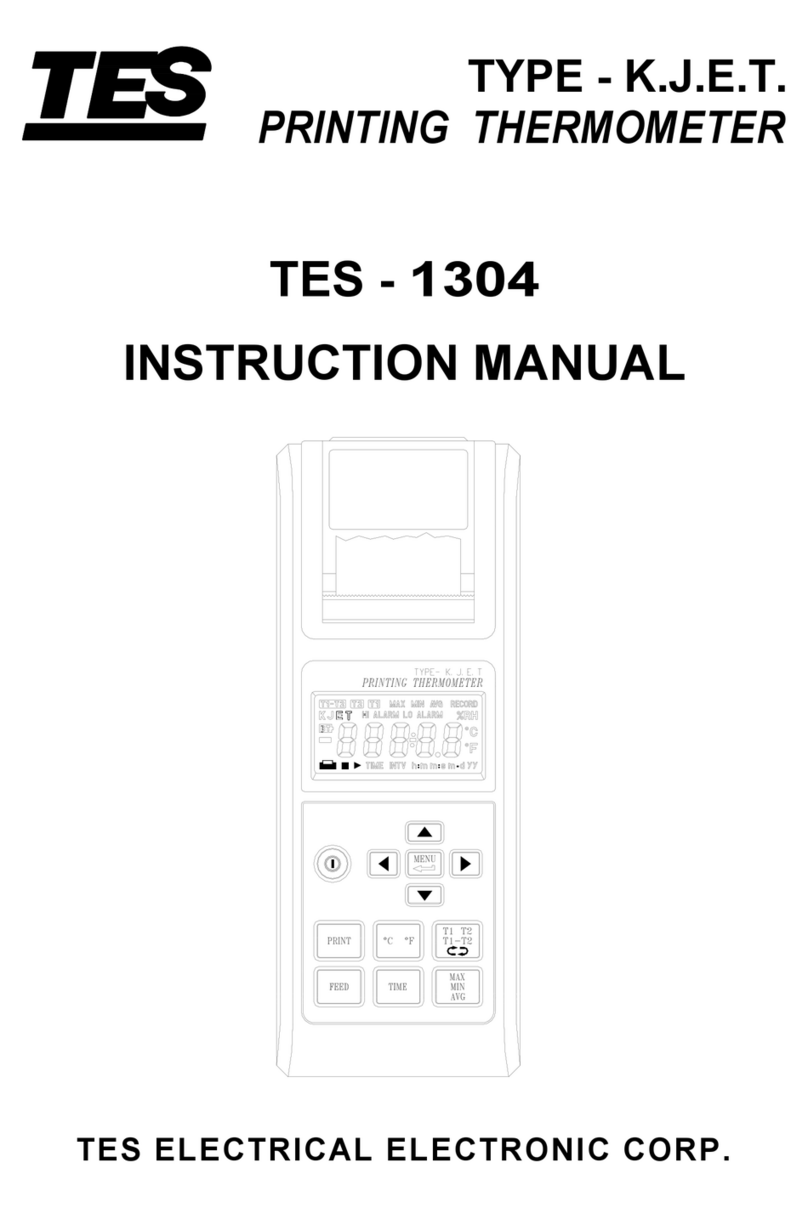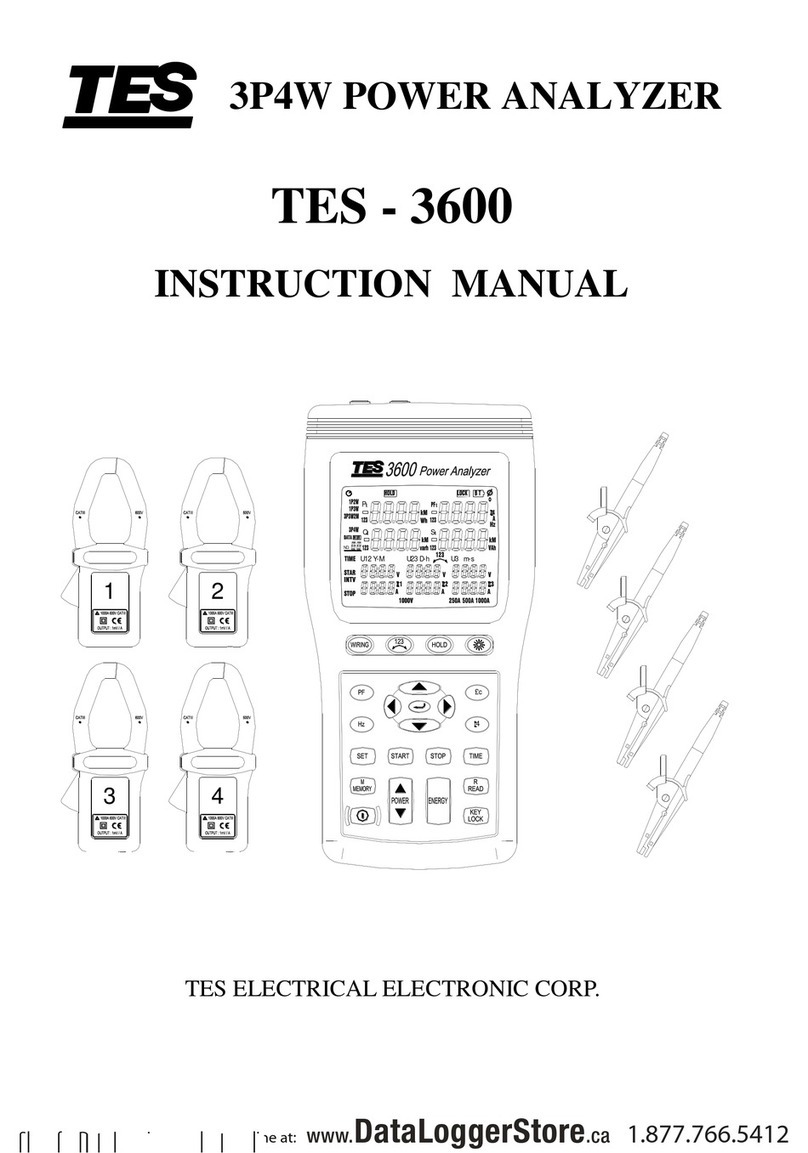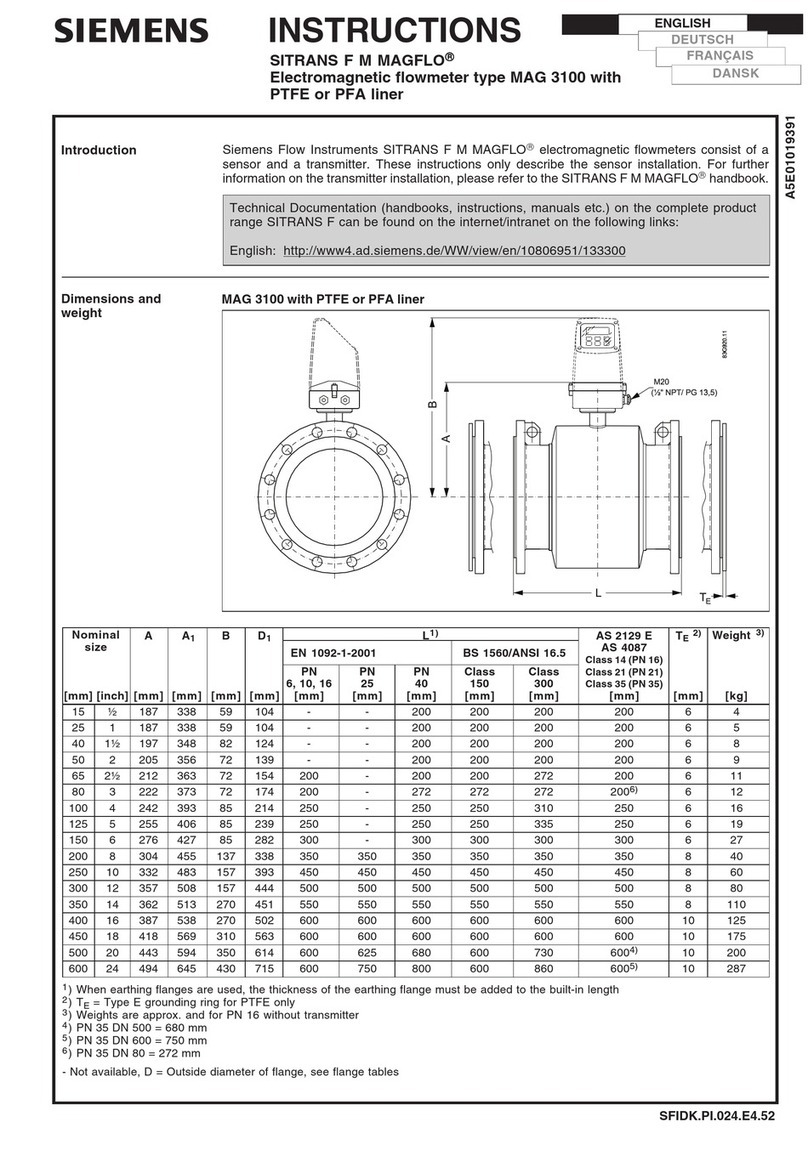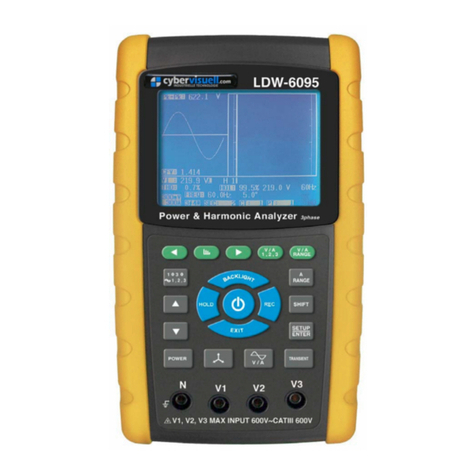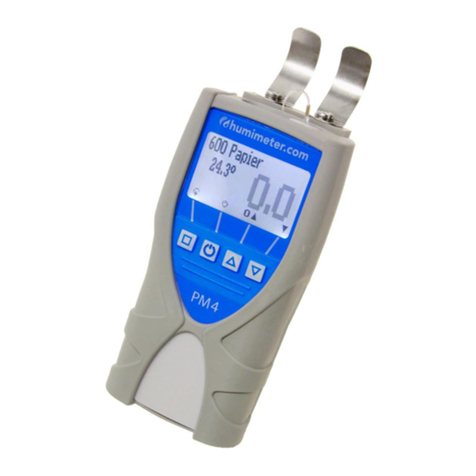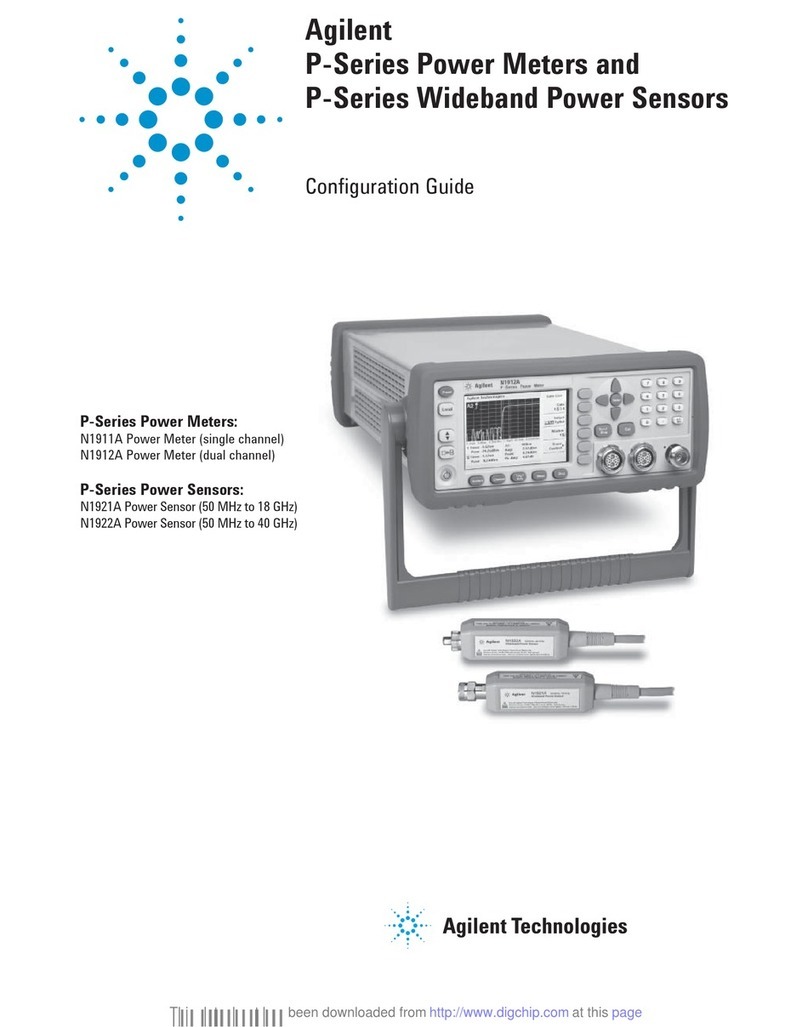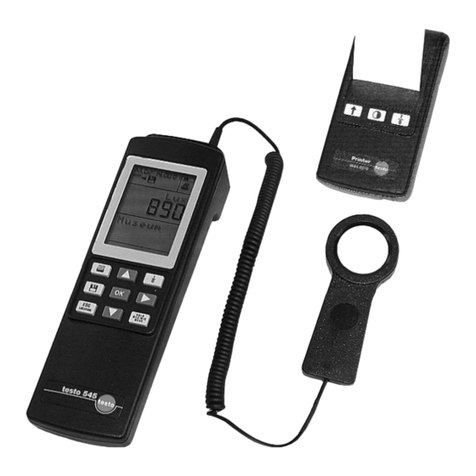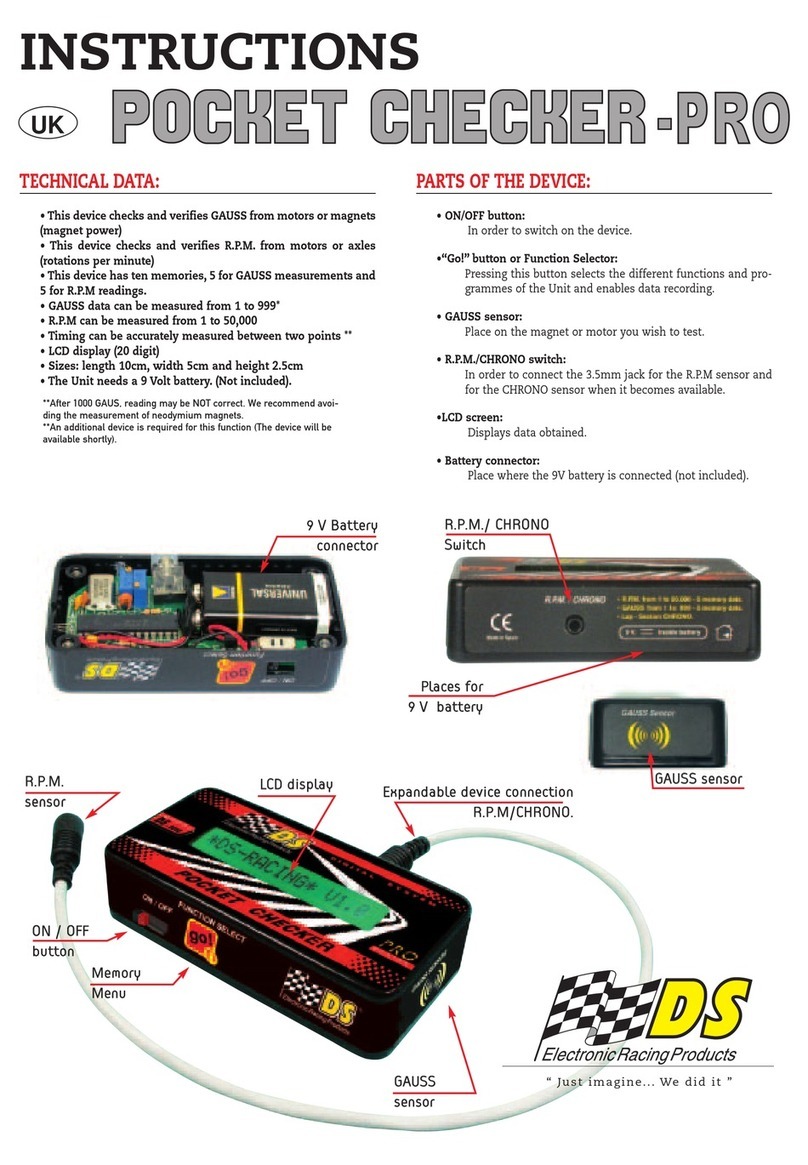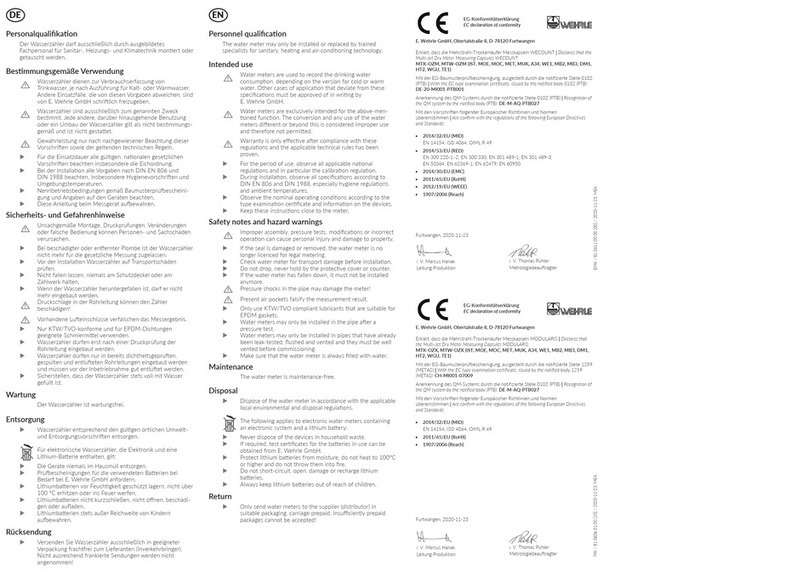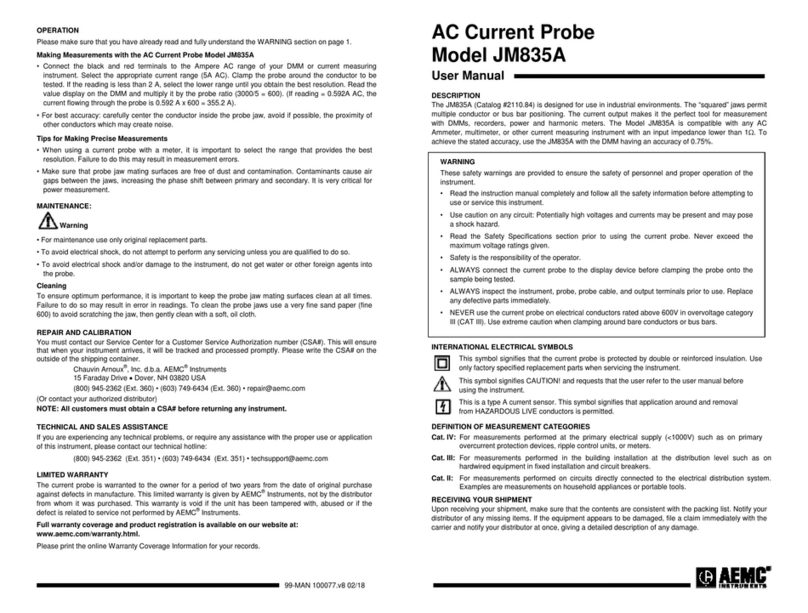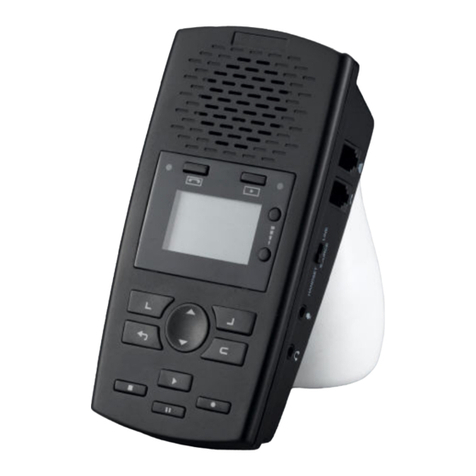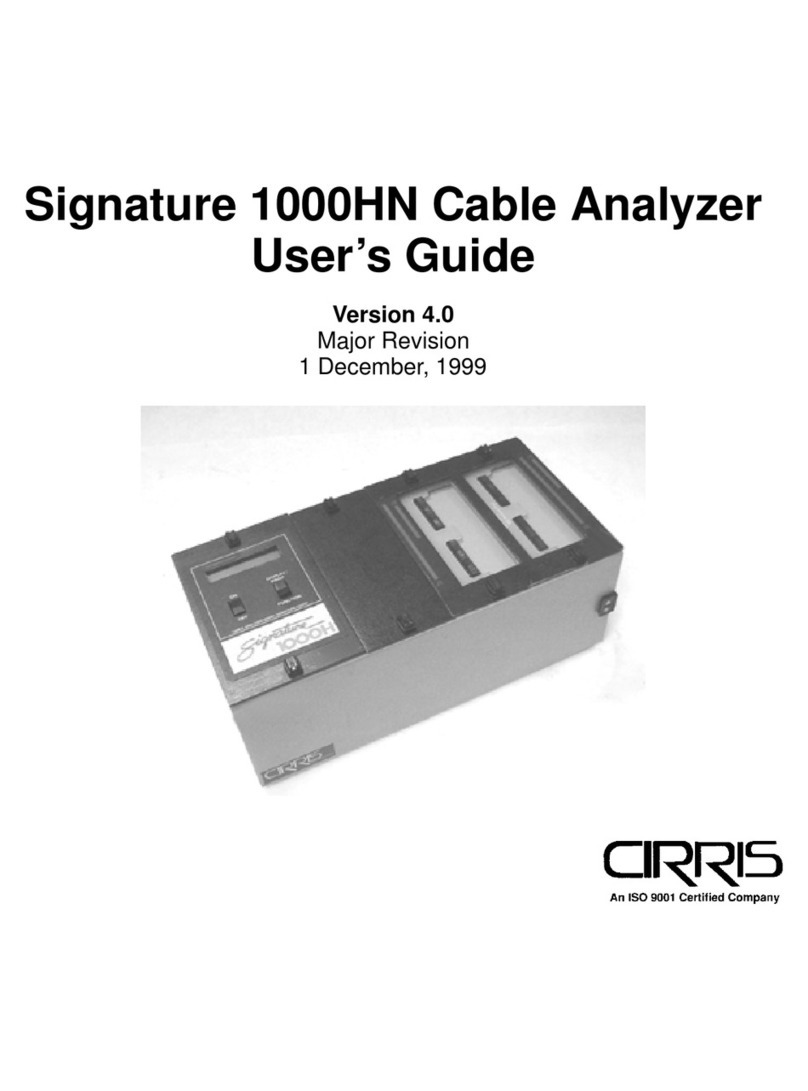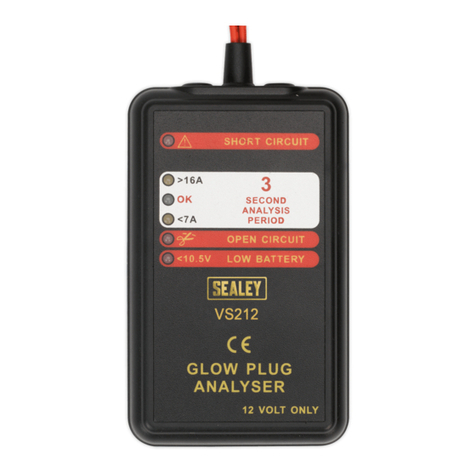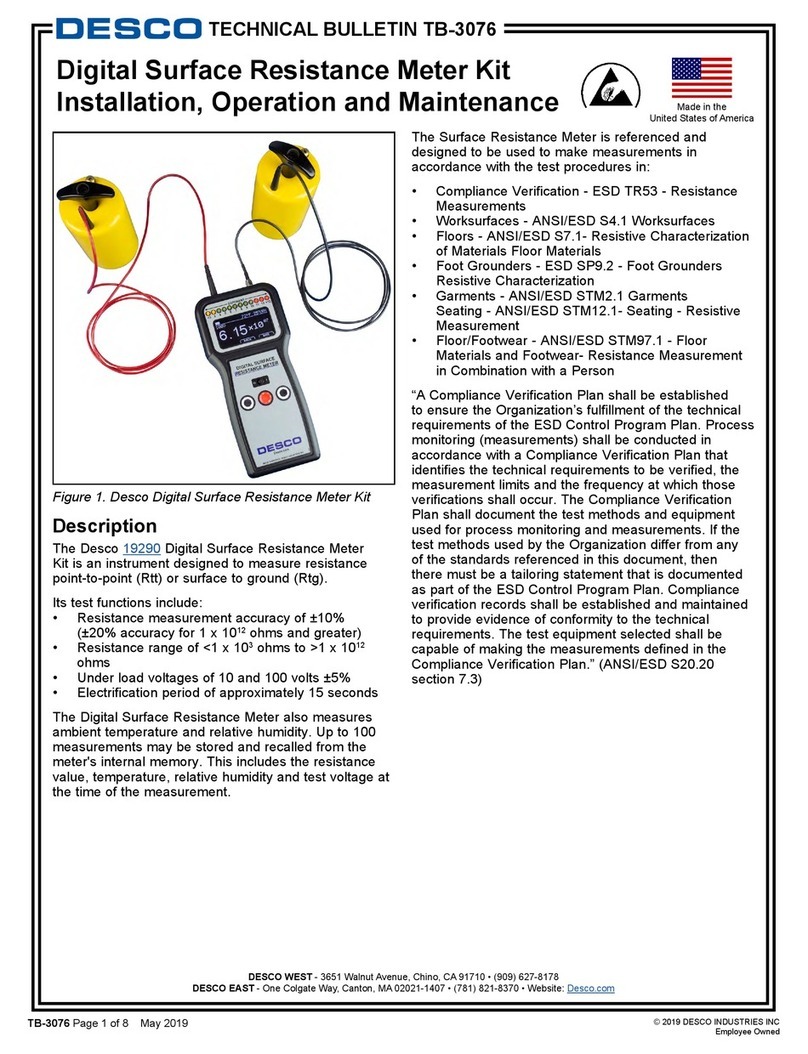TES TES-593R User manual

ELECTROSMOG METER
TES-593R
INSTRUCTION
MANUAL
Z
Y
X
AVGMAX
2
TES ELECTRICAL ELECTRONIC CORP.


CONTENTS
Title Page
1. SAFETY INFORMATION.......................................................1
2. INTRODUCTION....................................................................2
2-1 Fundamentals......................................................................2
2-2 Application...........................................................................4
2-3 Features ..............................................................................5
3. SPECIFICATIONS .................................................................6
3-1 General specifications .........................................................6
3-2 Electrical specifications........................................................7
4. OPERATION..........................................................................8
4-1 Front panel controls description...........................................8
4-2 LCD display description..................................................... 11
4-3 Use E-field sensor .............................................................13
4-4 Explanatory notes..............................................................13
4-5 Setting the meter ...............................................................16
4-6 Making measurements ......................................................22
4-7 Manual data memory storing individual measured values.23
4-8 Setting current data and time.............................................25
4-9 LCD backlight function.......................................................26
5. BATTERY CHARGING ........................................................26
※
Copyright ©
2020 TES Electrical Electronic Corp. All rights reserved.

1
1. SAFETY INFORMATION
CAUTION
•When first use the meter or prolonged storage the meter,
please charge the meter at least 10 minutes then use the
meter.
•Before making a measurement, check if the low battery
symbol (
+
) is shown on the display as soon as the meter
is switched on or the battery remained capacity indicate
“ ” symbol only 20%, please charging the battery.
•Avoid shaking the meter, particularly in the measurement mode.
•The accuracy and function of the meter may be adversely
affected by the specified limits outside and improper handling.
DANGER !
•In some cases, work in the vicinityof powerful radiation sources
can be a risk of your life.
•Be aware that persons with electronic implants (e.g. cardiac
pacemakers) are subject to particular dangers in some cases.
•Observe the local safety regulations of the facility operation.
•Observe the operating instructions for equipment which is used
to generate, conduct or consumer electromagnetic energy.
•Be aware that secondary radiators (e.g. reflective objects such
as a metallic fence) can cause a local amplification of the field.
•Be aware that the field strength in the near vicinity of radiators
increases proportionally to the inverse cube of the distance.
This means that enormous field strengths can result in the
immediate vicinity of small radiation sources (e.g. leak in
waveguides, inductive ovens).

2
•Field strength measuring device can underrate pulsed signals.
Particularly with radar signals, significant measurement errors
can arise.
•
All field strength measuring devices have a limited specified
frequency range. Fields with spectral components outside of this
frequency range are generally incorrectly evaluated and tend to be
underrated. Before using field strength measuring devices, you
should thus be certain that all field components to be measured lie
in the specified frequency range of the measuring device.
2. INTRODUCTION
2-1 Fundamentals
Electromagnetic pollution:
This Meter used to indicate electromagnetic pollution
generated artificially. Wherever there is a voltage or a
current, the electric (E) and magnetic (H) fields arise. All
types of radio broadcasting and TV transmitters produce
electromagnetic fields, and they also arise in industry,
business and the home, where they affect us even if our
sense organs perceive nothing.
Electric field strength (E):
A field vector quantity that represents the force (F) on an
infinitesimal unit positive test charge (q) at a point divided by
that charge. Electric field strength is expressed in units of
volts per meter (V/m).
Use the units of electric field strength for measurements in the
following situations:
•In the near-field area of the source.
•Where the nature of the electromagnetic field is unknown.

3
Magnetic field strength (H):
Afield vector that isequal to the magnetic flux density divided
by the permeability of the medium. Magnetic field strength is
expressed in units of amperes per meter (A/m).
The meter uses of magnetic field strength for measurements
only in the far-field area of the source.
Power density (S):
Power per unit area normal to the direction of propagation,
usually expressed in units of watts per square meter (W/m
2
) or,
for convenience, units such as milliwatts per square
centimeter (mW/cm
2
).
The characteristic of electromagnetic fields:
Electromagnetic fields propagate as waves and travel at the
speed of light (c). The wavelength is proportional to the
frequency.
λ(wavelength) =
c
(
speed of light
)
f (frequency)
If the distance to the field source is less than three
wavelength, then we are usually in the near-field. If the
distance is more than three wave length, the far-field
conditions usually hold.
In the near-field, the ratio of electric field strength (E) and
magnetic field strength (H) is not constant, so we have to
measure each separately.
In the far-field, however, it is enough to just measure one field
quantity, then the other could be computed accordingly.

4
2-2 Application
Quite often routine operation, maintenance and service work
has to be done in areas where active electromagnetic fields are
present, e.g. in broadcasting stations, etc. Additionally, other
employees may be exposed to electromagnetic radiation. In
such cases, it is essential that personnel are not exposed to
dangerous levels of electromagnetic radiation, such as:
High frequency (RF) electromagnetic wave field strength
measurement.
Mobil phone base station antenna radiation power
density measurement.
Wireless communication applications (CW, TDMA, GSM,
DECT).
RF power measurement for transmitters.
Wireless LAN (Wi-Fi) detection, installation.
Spy camera, wireless bug finder.
Cellular/Cordless phone radiation safety level.
Microwave oven leakage detection.
Personal living environment EMF safety.

5
2-3 Features
The meter is a broadband device for monitoring high-frequency
radiation in the range from 10MHz to 8GHz. The
non-directional electric field and high sensitivity also allow
measurements of electric field strength in TEM cells and
absorber rooms.
The unit of measurement and the measurement types have
been selected to expressed in units of electrical and magnetic
field strength and power density.
At high frequencies, the power density is of particular
significance.
It provides a measure of the power absorbed by a person
exposed to the field. This power level must be kept as low as
possible at high frequencies.
The meter can be set to display the instantaneous value or the
maximum value measured. Instantaneous and maximum value
measurements are useful for orientation, e.g. when first entering
an exposed area.
10MHz to 8GHz Frequency range
For isotropic measurements of electromagnetic fields
Non-directional (isotropic) measurement with three-channel
measurement sensor.
High dynamic range due to three-channel digital results
processing.
Configurable alarm threshold and memory function
Use rechargeable lithium-ion battery pack
LCD backlight function
Easy & safety to use

6
3. SPECIFICATIONS
3-1 General specifications
•Measurement method: Digital, triaxial measurement.
•Directional characteristic: Isotropic, triaxial.
•Measurement range selection: One continuous range.
•
Display resolution
: 0.1mV/m, 0.1
µ
A/m, 0.1
µ
W/m
2
, 0.001
µ
W/cm
2
•Setting time: Typically 1s (0 to 90% of measurement value).
•Display refresh rate: Typically 0.5 seconds
•Display type: Liquid-crystal (LCD), 4 digit.
•Audible alarm: Buzzer.
•Units: mV/m, V/m, µA/m, mA/m, µW/m
2
, mW/m
2
, W/m
2
,
µW/cm
2
, mW/cm
2
•Display value: Instantaneous measured value, maximum
value or maximum average value.
•Alarm function: Adjustable threshold with ON/OFF.
•Calibration factor CAL: Adjustable.
•Manual data memory and read storage: 99 data sets.
•Rechargeable lithium-ion battery: 3.6V, 1940mAh
•Battery charging time: Approx. 3 hours
•Battery operation time: Approx. 10 hours
•Auto power off: 5 minutes.
•Operating temperature range: 0℃to +50℃
•Operating humidity range: 25% to 75%RH
•Storage temperature range: -10℃to +60℃
•Storage humidity range: 0% to 80%RH
•Dimensions: Approx. 67(W)×60(T)×247(L)mm.
•Weight (including battery): Approx. 250g
•Accessories: Instruction manual, Rechargeable Lithium-ion
battery, Carrying case, AC adaptor (DC 5V 1.5A).

7
3-2 Electrical specifications
Unless otherwise stated, the following specifications hold
under the following conditions:
•The meter is located in the far-field of a source, the sensor
head is pointed towards the source.
•Ambient temperature: +23℃±3℃
•Relative air humidity: 25% to 75%
Sensor type: Electrical field (E)
Frequency range: 10MHz to 8GHz
Specified measurement range:
•CW signal (f > 10MHz): 20mV/m to 108.0V/m,
53µA/m to 286.4mA/m,
1µW/m
2
to 30.93W/m
2
,
0µW/cm
2
to 3.093mW/cm
2
Dynamic range: Typically 75dB
Absolute error at 1 V/m and 10 MHz: ±1.0dB
Frequency response:
•Sensor taking into account the typical CAL factor:
±1.0dB (10MHz to 1.9GHz)
±2.4dB (1.9GHz to 8GHz)
•Isotropy deviation: Typically ±1.0dB (f>10MHz)
•Overload limit: 10.61mW/cm
2
(200V/m)
•Thermal response (0 to 50℃): ±0.5dB

8
4. OPERATION
4-1 Front panel controls description
Z
Y
X
AVGMAX
2
(1). E-field sensor.
(2). LCD display.
(3). key: Press this key to turn the meter on or off.
(4). key: Press this key to change sequential:
“Instantaneous”→“Max. instantaneous” →
“Max. average”.

9
(5). key:
Press this key to change units selector: “mV/m or V/m” →
“µA/m or mA/m” →“µW/m
2
, mW/m
2
or W/m
2”
→“µW/cm
2
or
mW/cm
2”
”
Press and hold this key while turning the meter on to
disable the audible sound, the “ ” symbol will disappear.
3Press this key for 3 seconds to turn on or off the LCD
backlight. When no button is pressed at 30 seconds then
the backlight auto off.
(6). key:
Press this key to switch to display date and time.
Press and hold this key while turning the meter on to the
alarm setting mode, press key two times to exit this
mode.
3Press this key for 3 seconds to switch the alarm function on
or off.
(7). key: Press this key to enter the current data and time
setting mode, press this key again to exit this
mode.
(8). key:
Press this key to change sensor axis selector: “All axis” →
“X axis” →“Y axis” →“Z axis”.
Press and hold this key while turning the meter on to switch
the device to the calibration factor setting mode, press
key to exit this mode.

10
(9). key:
Press this key one time to store one data set to memory.
Press and hold this key while turning the meter on to enter
the clear manually recorded data mode, press key to
exit this mode.
(10). key:
Press this key to switch to the manual data reading mode,
press this key again to exit this mode.
Press and hold this key while turning the meter on to
disable the auto power off function, the “ ” symbol will
disappear.
(11). ⊳ key: Setting current date and time, datalogging
interval time, alarm setting value, calibration
factor setting value, or recall manual data
memory to read memory data in cycles
control keys.
(12). AC adaptor input socket: DC 5V 1.5A

11
4-2 LCD display description
Z
Y
X
AVGMAX
2
(1). : Auto power off function on / off.
(2). : Displayed : Audible sound function on / off.
(3). MAX : Maximum measured value displayed.
(4). MAX AVG : Maximum average value displayed.
(5).
+
: Low battery indication.
(6). Units : mV/m and V/m : Electric field strength.
µA/m and mA/m : Magnetic field strength.
µW/m
2
, mW/m
2
,
W/m
2
, µW/cm
2
and mW/cm
2
: Power
density
(7). : Measured value displayed as per selected mode and
selected units.
(8). : Manual stored measured value to memory indication,
displays one time store one sets data into the memory.
(9). : Read manual data memory mode indication.

12
(10). : Manual data memory address number (1~99).
: The manual data memory full indication.
(11). ALARM :Alarm function on / off or alarm setting indication.
(12). ▲: When the alarm function is on , this is the indication if
measured value exceeds the limit.
(13). : hh : mm : ss Time displayed.
: YY : MM : DD Date displayed.
(14). CAL : Calibration factor indication or setting indication (from
0.20 to 25.00).
(15). Z: Z axis measured value displayed.
(16). Y: Y axis measured value displayed.
(17). X: X axis measured value displayed.
XYZ : Triaxial measured value displayed.
(18). : Analog bargraph of each axis (X,Y or Z)
measured dynamic range indication for observing
trends.
(19). : Battery remained capacity displayed.

13
4-3 Use E-field sensor
The actual 3-channel sensor is located in the head part of the
meter. The three voltages generated by the sensor are fed back
to the meter. In far-fields, an E-field sensor is preferable due to
the greater bandwidth. The E-field sensorfor frequencies is from
10MHz to 8GHz.
The meter is a small portable instrument that measures the electric
field presented in the atmosphere of the measurement sensor
surroundings.
The measurement of the field is done by moving the aerial of the
sensor in the desired measured environment.
You obtain a direct wide band measurement of the field that the
measurement sensor is subjected to. To find the value of the
field emitted by a source of interference, simply point the aerial
towards it and get as close as possible (the value of the field is
inversely proportional to the distance of the sensor/emission
source). The operator must take care not to be between the
source of disturbance and the zone to be checked: the human
body shields electromagnetic fields. The E-field sensor is
isotropic, it does not require special handing. Its sensitive part
measures the field according to 3 axes without the aerial having
to be moved in the 3 planes. Simply point it at the target to
make the measurement.
4-4 Explanatory notes
4-4-1 Units of measurement
The meter measures the electrical component of the field, the
default units are those of electrical field strength (mV/m, V/m).
The meter converts the measurement values to the other units
of measurement, i.e. the corresponding magnetic field
strength units (µA/m, mA/m) and power density units (µW/m
2
,
mW/m
2
, W/m
2
, µW/cm
2
or mW/cm
2
) using the standard
far-field formulate for electromagnetic radiation.
The conversion is invalid for near-field measurements, as
there is no generally valid relationship between electrical and
magnetic field strength in this situation. Always use the default
units of the sensor when making near-field measurements.

14
4-4-2 Result modes
The bar graph display always shows each axis (X, Y or Z)
the instantaneous measured dynamic range value. The
digit display shows the instantaneous or result according to
one of three modes which can be selected :
•Instantaneous: The display shows the lastvalue measured
by the sensor, no symbol is displayed.
•Maximum instantaneous (MAX): The digital display
shows the highest instantaneous value measured, the
“MAX” symbol is displayed.
•
Maximum average (MAX AVG)
: The digital display shows
the highest average value measured, the “MAX AVG” symbol
is displayed.
t
Max. Hold
Average Actual
Max. Average
Field strength
4-4-3 Calibration factor (CAL)
The calibration factor CAL serves to calibrate the result
display. The field strength value measured internally is
multiplied by the value of CAL that has been entered and
the resulting value is displayed. The CAL setting range is
from 0.20 to 25.00.

15
The CAL factor is often used as a means of entering the
sensitivity of the field sensor in terms of its frequency
response in order to improve measurement accuracy.
Frequency-dependent sensor calibration factors are provided
for this application. In many cases, the measurement
accuracy will be sufficient even if the frequency response of
sensor calibration factoris ignored. CALcan be set to 1.00 in
such cases.
E-Field typically calibration data:
Frequency CAL
10MHz 17.04
50MHz 2.13
100MHz 1.37
200MHz 1.19
300MHz 0.69
433MHz 0.78
500MHz 1.38
600MHz 2.12
700MHz 1.66
800MHz 1.40
900MHz 1.40
1.8GHz 2.06
2.4GHz 0.66
3.5GHz 1.05
5.4GHz 2.20
8.0GHz 3.16

16
4-4-4 Alarm limit value (ALARM)
The alarm limit value is used to monitor the display value
automatically. It controls the alarm indication function. The
alarm limit value can be edited in the displayed V/m unit.
※ Alarm limit function is only used for total three axial value
comparator.
4-5 Setting the meter
4-5-1 Setting the units of measurement
With the key as follows.
X
Y
Z Z
Y
X
2
X
Y
ZZ
Y
X
2
Units
(a)
(d) (c)
(b)
Mannal data memory number
(a). Electric field strength (V/m).
(b). Computed magnetic field strength (mA/m).
(c). Computed power density (mW/m
2
).
(d). Computed power density (µW/cm
2
).

17
4-5-2 Setting the result mode
Instantaneous result mode is automatically set when the
meter is turned on.
With the key as followings:
MAX
AVGMAX
Instantaneous Max. Instantaneous
Max. average
Table of contents
Other TES Measuring Instrument manuals
